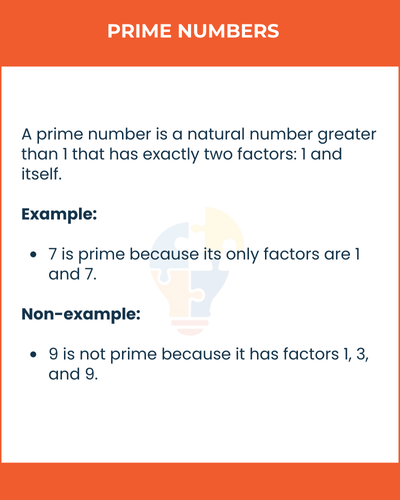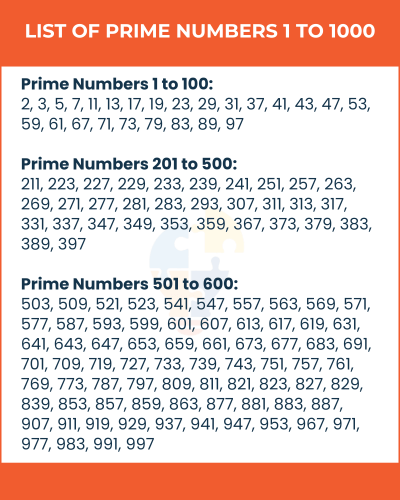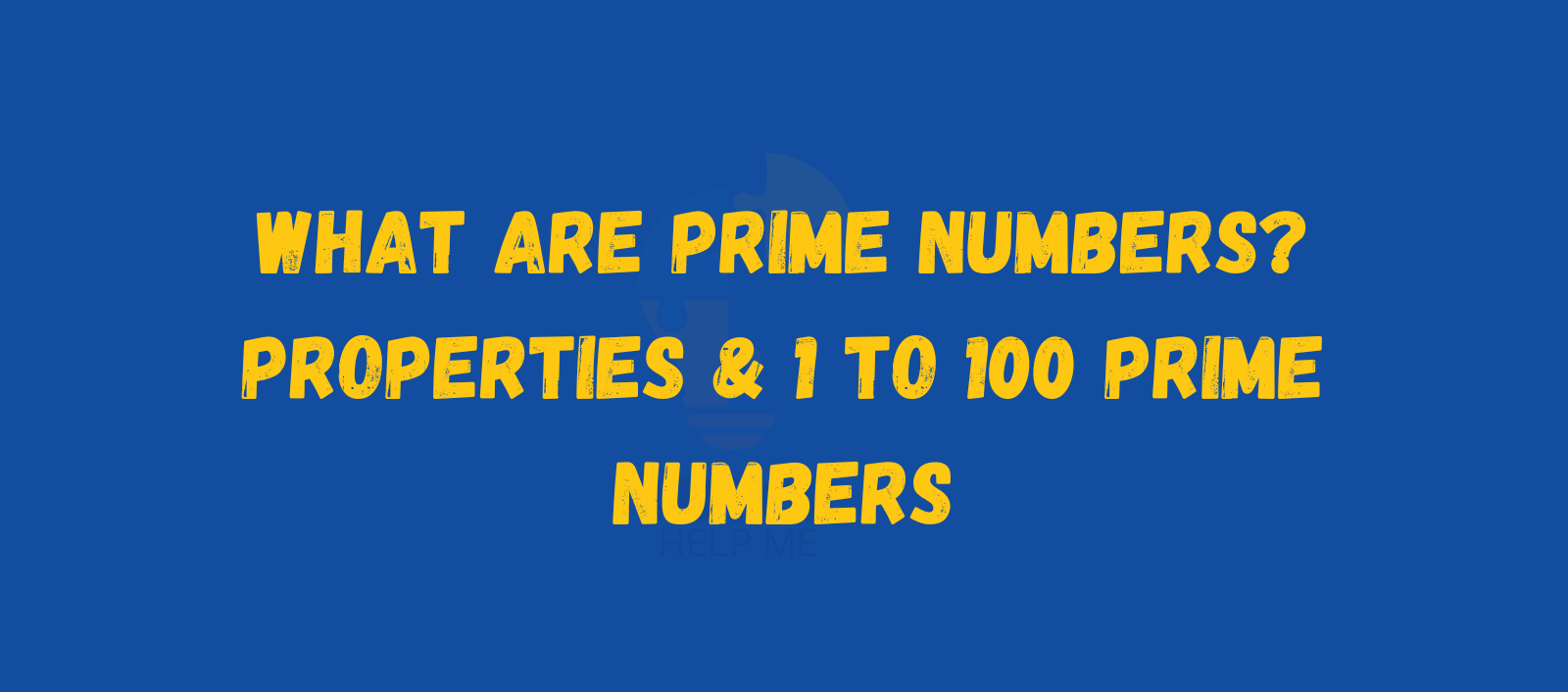Prime numbers are the building blocks of mathematics. They are special numbers that cannot be divided evenly by anything except 1 and themselves.
This blog will explain what prime numbers are, their history, properties, methods to find them, and interesting facts. By the end, you’ll clearly understand why prime numbers are so important in maths and beyond.
Let’s begin with the definition.
What Are Prime Numbers?
A prime number is a natural number greater than 1 that has exactly two factors: 1 and itself.
- Example: 7 is prime because its only factors are 1 and 7.
- Non-example: 9 is not prime because it has factors 1, 3, and 9.

History of Prime Numbers
Prime numbers have fascinated mathematicians since ancient times.
- Greek mathematician Euclid (around 300 BC) proved that there are infinitely many prime numbers.
- In India, mathematician Eratosthenes created the Sieve of Eratosthenes, an early method to find primes.
- Over centuries, prime numbers became central in number theory and modern applications like cryptography.
"Get success in maths with our 1-on-1 online maths tutors."
List of Prime Numbers 1 to 1000
Prime Numbers 1 to 100:
2, 3, 5, 7, 11, 13, 17, 19, 23, 29, 31, 37, 41, 43, 47, 53, 59, 61, 67, 71, 73, 79, 83, 89, 97
Prime Numbers 101 to 200:
101, 103, 107, 109, 113, 127, 131, 137, 139, 149, 151, 157, 163, 167, 173, 179, 181, 191, 193, 197, 199
Prime Numbers 201 to 300:
211, 223, 227, 229, 233, 239, 241, 251, 257, 263, 269, 271, 277, 281, 283, 293
Prime Numbers 301 to 400:
307, 311, 313, 317, 331, 337, 347, 349, 353, 359, 367, 373, 379, 383, 389, 397
Prime Numbers 401 to 500:
401, 409, 419, 421, 431, 433, 439, 443, 449, 457, 461, 463, 467, 479, 487, 491, 499
Prime Numbers 501 to 600:
503, 509, 521, 523, 541, 547, 557, 563, 569, 571, 577, 587, 593, 599
Prime Numbers 601 to 700:
601, 607, 613, 617, 619, 631, 641, 643, 647, 653, 659, 661, 673, 677, 683, 691
Prime Numbers 701 to 800:
701, 709, 719, 727, 733, 739, 743, 751, 757, 761, 769, 773, 787, 797
Prime Numbers 801 to 900:
809, 811, 821, 823, 827, 829, 839, 853, 857, 859, 863, 877, 881, 883, 887
Prime Numbers 901 to 1000:
907, 911, 919, 929, 937, 941, 947, 953, 967, 971, 977, 983, 991, 997

Properties of Prime Numbers
Prime numbers follow special properties:
The Only Even Prime
- 2 is the only even prime number.
- All other even numbers are divisible by 2.
“Book a free assessment for maths tutoring.”
Infinite Primes
- There is no end to prime numbers.
- Euclid proved primes are infinite.
Fundamental Theorem of Arithmetic
- Every integer greater than 1 is either prime or can be written as a product of prime numbers.
- Example: 60 = 2 × 2 × 3 × 5
Form of Primes
- Except for 2 and 3, all primes are of the form 6n ± 1.
- Example: 5, 7, 11, 13
Coprime Pairs
- Two numbers are coprime if their greatest common factor (GCF) is 1.
- Example: (8, 15) are coprime.
No Largest Prime
- Primes go on forever, so there is no largest prime number.
Way to Find Prime Numbers
There are different methods to check if a number is prime.
Trial Division
- Divide the number by smaller numbers.
- If divisible, it’s not prime.
Sieve of Eratosthenes
- Write numbers in order.
- Cross out multiples of each prime starting from 2.
- Remaining numbers are prime.
Prime Factorization
- Check if the number can be broken into smaller prime numbers.
- If it cannot, it is prime.
Facts About Prime Numbers
- 2 is the smallest and only even prime number.
- 3 is the only prime that is one less than a multiple of 4.
- Prime numbers are used in encryption and cybersecurity.
- Twin primes are pairs of primes that differ by 2 (e.g., 11 and 13).
- The largest known prime discovered has over 24 million digits.
Examples of Prime Numbers
- Small primes: 2, 3, 5, 7, 11
- Medium primes: 101, 113, 131
- Large primes: Numbers with thousands of digits used in security codes
Conclusion
Prime numbers are special numbers greater than 1 with only two factors, 1 and themselves. From the smallest prime, 2, to infinitely large ones, they are central to mathematics.
Their properties, such as forming the basis of factorization, make them essential in arithmetic, algebra, and modern applications like cryptography.
Learning how to find and use prime numbers strengthens mathematical skills and shows their importance in both theory and real-world use.
Read More What Are Complex Numbers? Properties & Operations
FAQs
Q1. What is a prime number?
A prime number is a natural number greater than 1 with exactly two factors: 1 and itself.
Q2. What is the only even prime number?
The only even prime number is 2.
Q3. Who discovered prime numbers?
Prime numbers were studied in ancient Greece by Euclid and others.
Q4. Are prime numbers infinite?
Yes, there are infinitely many prime numbers.
Q5. What is the largest prime number?
The largest known prime has over 24 million digits.
Q6. How can I find prime numbers?
You can use trial division, prime factorization, or the Sieve of Eratosthenes.
Q7. Is 1 a prime number?
No, 1 has only one factor, so it is neither prime nor composite.
Q8. What are twin primes?
Twin primes are pairs of primes that differ by 2, such as (11, 13).
Q9. Are all odd numbers prime?
No, some odd numbers like 9 and 15 are not prime.
Q10. Why are prime numbers important?
They are building blocks of numbers and used in encryption, coding, and mathematics.

